Highland Cattle
Bos Taurus
Natively found in the Scottish Highlands!
Advertisement
Highland Cattle Scientific Classification
- Kingdom
- Animalia
- Phylum
- Chordata
- Class
- Mammalia
- Order
- Artiodactyla
- Family
- Bovidae
- Genus
- Bos
- Scientific Name
- Bos Taurus
Read our Complete Guide to Classification of Animals.
Highland Cattle Conservation Status
Highland Cattle Facts
- Main Prey
- Grass, Leaves, Flowers
- Habitat
- Mountainous and wet grasslands
- Predators
- Human, Wolf, Coyote
- Diet
- Herbivore
- Average Litter Size
- 1
View all of the Highland Cattle images!
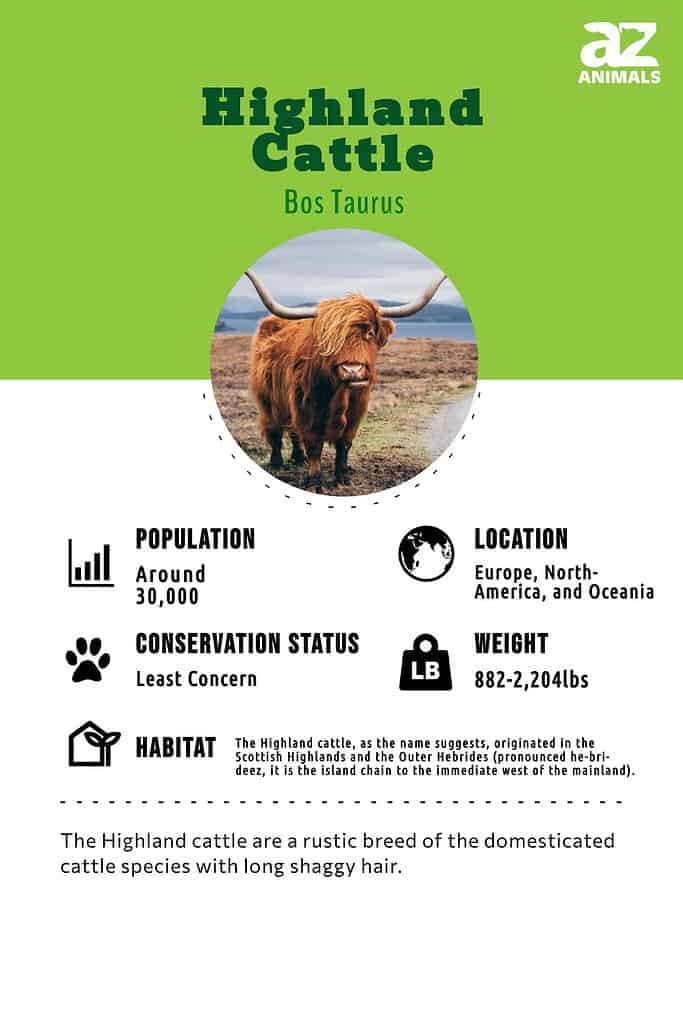
“The Highland cattle are a rustic breed of the domesticated cattle species.“
Originally hailing from the high elevations of the scenic Scottish Highlands, this breed is now raised worldwide for meat production.
Judging by its behavior and physical characteristics, it is very much a quintessential cattle breed.
But the Highland cattle also has many distinct features, including its sturdy constitution and incredibly long hair.
3 Incredible Highland Cattle Facts
- The Highland cattle produce leaner, tender meat compared to most other breeds of cattle. This meat is sometimes highly sought after by meat connoisseurs for its quality.
- The Highland cattle have horizontal pupils to keep track of potential predators coming from the periphery. This is an adaptation shared by all breeds of cattle and many other hoofed mammals.
- The Highland cattle are primarily a product of artificial selection. This means that people bred the cattle’s individual traits and characteristics based on usefulness to human society. This artificial selection went on for thousands of years, long before people really understood the genetic science behind it.
Scientific Name

Highland Cattle
©AlterVista / Creative Commons
The Highland cattle, like all breeds of cattle, belongs to the species Bos taurus. The breed likely descended from longhorn cattle brought to Britain in the second millennium BC. After thousands of years of evolution in the Scottish Highlands, this breed was finally standardized at some point in the 19th century.
The first guidebook in 1885 described two different types of Highland cattle – a mainland type and an island type – but they’ve largely been crossbred into a single type with fewer distinct differences between them.
All domesticated cattle belong to the family Bovidae, which also includes buffalo, sheep, goats, bison, and antelope. This family, in turn, is part of the order Artiodactyla, which is shared by pigs, camels, hippos, giraffes, deer, and much more.
Together this order represents all living even-toed ungulates – essentially, hoofed animals that bear weight equally on two toes. Interestingly, the cetaceans are closely related to even-toed ungulates, having evolved from semi-aquatic hippo-like creatures millions of years ago.
Different Types of Cows
Here is a list of different types of cattle:
- Holstein Friesian cattle
- Hereford cattle
- Aberdeen Angus
- Simmental cattle
- Brown Swiss cattle
- Limousin cattle
- Belgian Blue
- Galloway cattle
- Belted Galloway
- Red Angus
- Brangus
- Braford
- Chillingham cattle
- Ongole cattle
- Beefalo
- Chianina
- Gelbvieh
- Parda alpina
- Cachena
- Senepol
- Dairy Shorthorn
- Horro
- Maine-Anjou
- Montbéliarde
- Nguni cattle
- British White cattle
- Lakenvelder cattle
- Retinta
- Albera
- Hallikar
- White Park cattle
- Heck cattle
- Beef Shorthorn
- Hungarian Grey
- Red Poll
- Corriente
- Podolica
- Australian Lowline
- Pustertaler Sprinzen
- English Longhorn
- French Brown
- Florida Cracker cattle
- Twinner
- Caracu
- Balancer
- Rathi cattle
- Pantaneiro
- Boškarin
- Swedish Red Poll
- Aubrac
Appearance
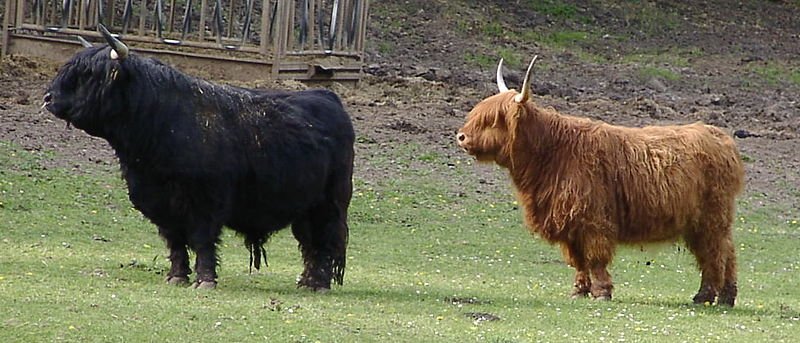
Highland Cattle
Like all other cattle, the terms bulls and cows are used to distinguish the sexes. There are several important differences between them. Bulls can weigh anywhere between 1,500 and 2,000 pounds, while cows typically weigh between 900 and 1,300 pounds.
This is about the weight of a small car. Another key difference is the shape of the horns. Bulls have horizontal horns with slightly bent tips, whereas cows have mostly sweeping curved horns. Cows also have an udder on their abdomen from which the milk derives.
The signature feature of all cattle is the four-chamber stomach. This allows the cattle to digest tough plant material that would be impossible or difficult for many other animals to consume. The first chamber of the stomach, also known as the rumen, can hold a massive amount of food – in some cattle, more than 25 gallons.
This chamber contains good beneficial bacteria that help the cattle digest food. After the food is processed by the rumen, part of the vegetation will be regurgitated as cud. This material will then be chewed over and swallowed again multiple times to fully break it down.
It takes up to 100 hours to fully digest food, which is one of the slowest rates in the animal kingdom. Although this process involved quite a few complex steps, it ensures the cattle access to bountiful food reserves of vegetation with little competition.
One distinct variation of this breed is the miniature Highland cattle. Although much rarer, the miniature cattle weigh up to 500 pounds and require far less grazing land and food. It also produces far less milk and meat.
Shaggy Hair
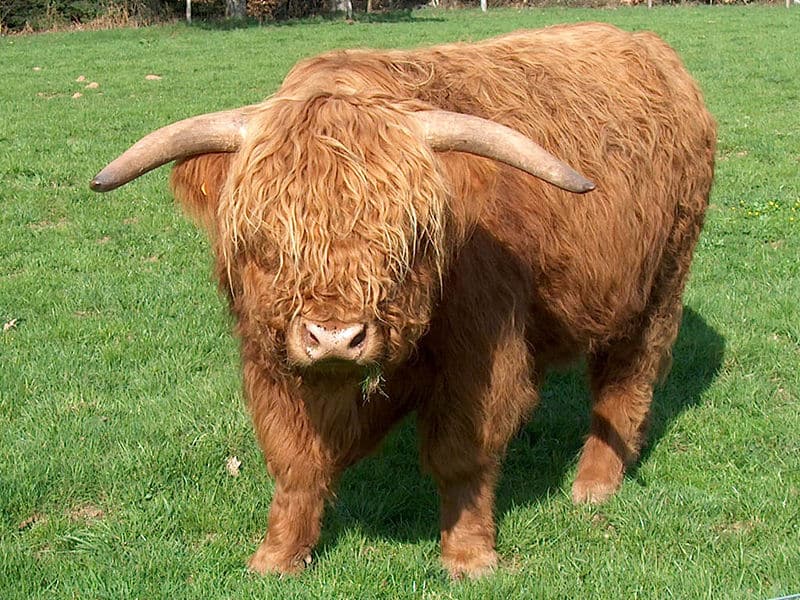
©Mahaba – Public Domain
The Highland cattle resemble domesticated cattle in almost all aspects. The major difference is the presence of long, shaggy hair all around its body. This hair is actually composed of two distinct layers: a downy inner coat and a longer oily outer coat, the longest of any cattle breed currently living.
The most common hair color is a sort of light ruddy red-orange. The breed can also be seen in black, gray, yellow, and a kind of creamy white.
Behavior

Highland cattle are noted for their long shaggy coats.
©attilio pregnolato/Shutterstock.com
Highland cattle are social species that graze together in large groups. They appear to have a distinct social hierarchy based on the dominance of other members, usually with a single dominant male among the group.
Both age and gender play an important role in the establishment of this hierarchy. This brings a measure of harmony to group cohesion. Highland cattle sleep in various short intervals throughout the day and especially at night.
Cattle can display a relatively complex range of emotions and temperaments such as fear, anxiety, stress, and affability. Their keen intelligence allows them to remember other creatures and places for a long amount of time, and their problem-solving ability is still the subject of scientific scrutiny.
Individual cattle also appear to have distinct personalities. They mostly rely on their vision, touch, chemicals, and sense of hearing to identify threats, find good grazing spots, and bond with other members of the group.
Habitat

Highland Cattle
The Highland cattle, as the name suggests, originated in the Scottish Highlands and the Outer Hebrides (pronounced he-bri-deez, it is the island chain to the immediate west of the mainland).
Beginning in the 19th century, the breed was brought by cattle herders to the rest of the world, including the United States, Canada, Australia, and Scandinavian countries. Various Highland cattle societies have cropped up around the world to promote its use by ranchers.
The breed rarely occurs in the wild. Instead, it occupies large grazing lands on human ranches and farms. Thanks to their thick coats of fur, Highland cattle are relatively tolerant to cold weather.
They have been known to reside at high elevations in the mountains, digging with their hooves to find buried food beneath the snow.
Population
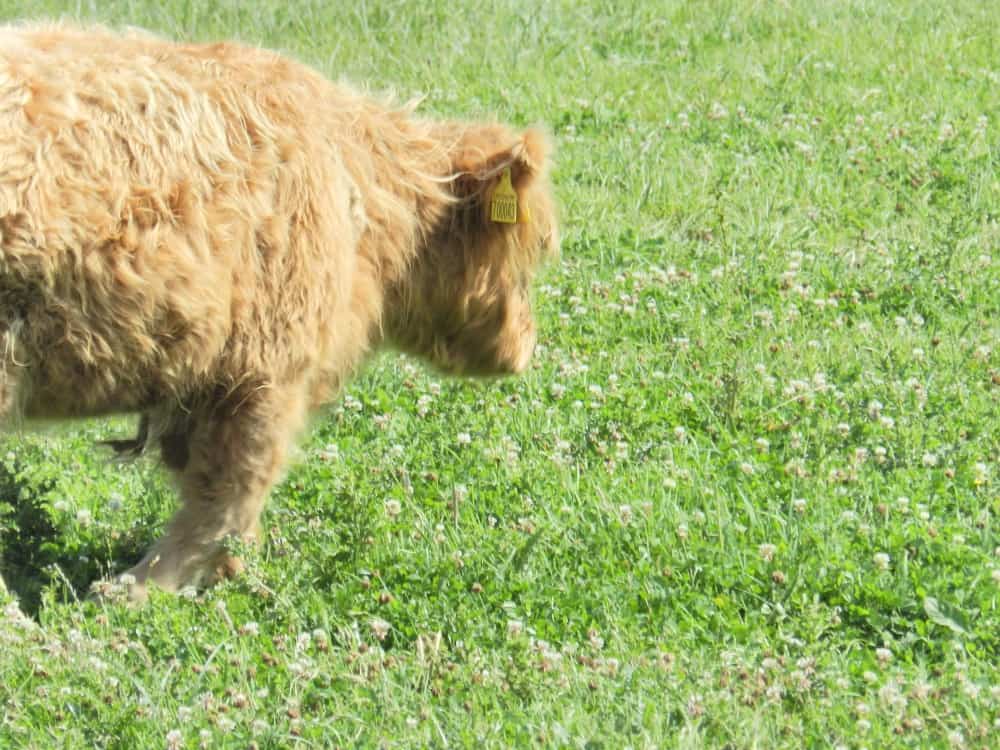
©Millie Bond – Copyright A-Z Animals
Based on a conservative estimate, there are more than 25,000 Highland cattle registered around the world, but there might be many more unregistered cattle as well. This is only a small percentage of the full cattle population, which is nearly a billion worldwide.
However, Highland cattle have provided a source of high-quality beef since the late 19th century. Because it is a domesticated species bred and raised for human consumption, population numbers are in no danger of dwindling for as long as people rely on them.
The breed is not currently classified by the IUCN Red List, which only considers the endangered status of wild species.
Diet
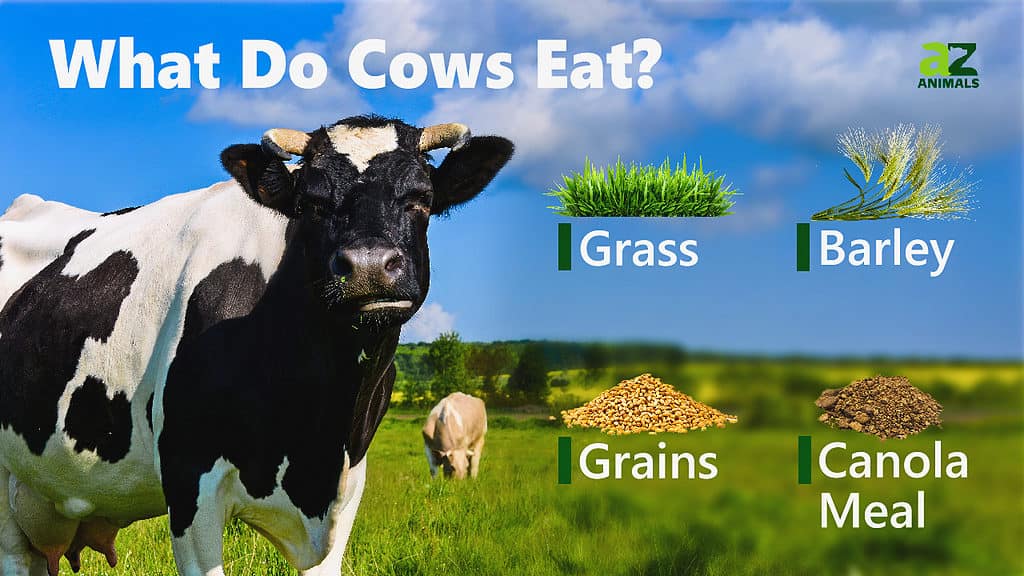
The Highland cattle primarily forage on grass and vegetation. Their body types, including their unique stomach, have been shaped over thousands of years of evolution to fit this specific grazing lifestyle. Cattle spend a great deal of their time every day simply consuming and digesting food.
They can consume up to 40 pounds of vegetation every single day. This grazing is actually a net good for the environment. Part of the breed’s diet consists of annoying pest plants that can mar a pasture.
Predators and Threats
Due to their enormous size, the Highland cattle are not easily tussled with. When threatened, their main defense is to charge a predator and try to gore it with their horns. For this reason, they are only threatened by the most dangerous apex predators such as wolves, cougars, and bobcats.
An entire group of Highland cattle provides a nearly impenetrable defense against predators. Rather than confronting a group directly, predators often choose to pick off wounded, young, old, or lone cattle that wander away from the group.
As a domesticated species, the spread, survival, and reproduction of the Highland cattle are heavily promoted and defended by humans. Domesticated cattle, as a species, are one of the most widespread mammals on the planet.
However, most cattle still end up slaughtered for their meat, so what’s good for the species is not necessarily good for the individual. The treatment of individual cattle can also vary from ranch to ranch. Some cattle may be treated humanely or even kept as pets.
Cattle are prone to many types of dangerous diseases, including respiratory infections, skin diseases, and viruses, some of which can be spread to humans.
Reproduction, Babies, and Lifespan

Highland Cattle with a baby calf.
The reproduction of Highland cattle is obviously of enormous interest to breeders. Because cattle breeding has practically been honed to a precise science, the cattle industry is deriving more productivity from cattle than ever before.
A young female cow, commonly referred to as a heifer, will have her first calf after about two to three years of age. Males typically achieve sexual maturity after about a year.
Breeders can choose whether the heifer is impregnated through natural means or artificial insemination. If through natural means, then cattle can breed at various times throughout the year.
The cow will carry the young calf for approximately nine to 10 months before it is born, about the same time as humans. Given the physical and mental costs required to raise the young, she will produce only one or two calves at a time.
The calf stays close to its mother for most of its early life, forming a close bond. The mother offers both milk and protection mostly without the help of the father.
The calf is weaned at around eight to 12 months of age. It will then achieve independence a short time later. The average individual has a lifespan of around 20 years, though they can sometimes live much longer. Cows may give birth to several calves throughout their lives.
View all 104 animals that start with HHighland Cattle FAQs (Frequently Asked Questions)
What do Highland cattle eat?
Highland cattle are herbivores, feeding exclusively on grass, leaves, clovers, and other prime vegetation.
What is a group of Highland cattle called?
The technical term for a group of Highland cattle is actually a fold, not a herd. This word comes from the name of the stone shelters in Scotland that were once used to protect the cattle from predators at night. It was then adapted to describe the group as a whole.
Where do Highland cattle live?
Highland cattle can be found on any farm where they are bred and raised. Due to their thick fur, they are well-adapted for colder, northern climates and somewhat less suitable for warmer climates. The distribution of cattle across farms around the world tends to reflect this fact. It is found primarily in colder climates in Scotland, the northern United States, and Canada. However, in one exception, they are also raised in Australia.
What are Highland cattle used for?
Most Highland cattle are raised and slaughtered exclusively for their meat. Though they may have once been used to produce milk by small families and farmers, modern industries rarely used for this purpose, as they are less suited than other cattle breeds. This is partly due to artificial selection. Some breeds are considered to produce higher quality meat, while others deliver higher milk yields.
Are Highland cattle aggressive?
Highland cattle have a good reputation for their even and calm temperament. But like most cattle, this breed can become aggressive when directly threatened, challenged, or annoyed. The bulls are also more aggressive than the cows on average.
What Kingdom do Highland Cattle belong to?
Highland Cattle belong to the Kingdom Animalia.
What class do Highland Cattle belong to?
Highland Cattle belong to the class Mammalia.
What phylum to Highland Cattles belong to?
Highland Cattles belong to the phylum Chordata.
What family do Highland Cattle belong to?
Highland Cattle belong to the family Bovidae.
What order do Highland Cattle belong to?
Highland Cattle belong to the order Artiodactyla.
What type of covering do Highland Cattle have?
Highland Cattle are covered in Hair.
What genus do Highland Cattle belong to?
Highland Cattle belong to the genus Bos.
What are some predators of Highland Cattle?
Predators of Highland Cattle include humans, wolves, and coyotes.
How many babies do Highland Cattle have?
The average number of babies a Highland Cattle has is 1.
What is an interesting fact about Highland Cattle?
Highland Cattle are natively found in the Scottish Highlands!
What is the scientific name for the Highland Cattle?
The scientific name for the Highland Cattle is Bos Taurus.
What is the lifespan of a Highland Cattle?
Highland Cattle can live for 15 to 22 years.
How fast is a Highland Cattle?
A Highland Cattle can travel at speeds of up to 25 miles per hour.
Thank you for reading! Have some feedback for us? Contact the AZ Animals editorial team.
Sources
- The Livestock Conservancy, Available here: https://livestockconservancy.org/index.php/heritage/internal/highland
- Marc Bekoff Ph.D. for Psychology Today, Available here: https://www.psychologytoday.com/us/blog/animal-emotions/201711/cows-science-shows-theyre-bright-and-emotional-individuals
- Tanya Dewey and Jessica Ng for Animal Diversity Web, Available here: https://animaldiversity.org/accounts/Bos_taurus/

















